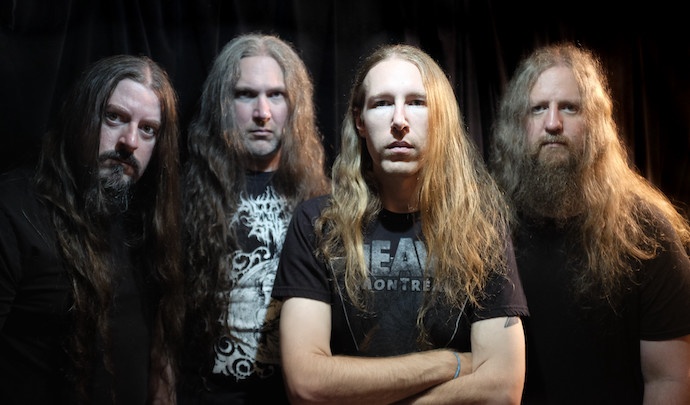
photo by Nick Richer
(Here we have Comrade Aleks‘ new interview of Nicolas Miquelon from the Québec band Norilsk, who released a new EP this past spring to tide us over ’til the next album.)
NCS’ constant followers should remember Norilsk. It’s a Canadian death-doom band who integrated elements of post metal into their music, and we interviewed Nicolas Miquelon (all instruments, vocals) a few years ago. But in case you forgot that, let me remind you of some facts about Norilsk.
The band is named after the world’s northernmost city and the second-largest city (after Murmansk) inside the Arctic Circle. Norilsk and Yakutsk are also the only large cities in the continuous permafrost zone. So you see the reason why Nicolas and his band-mate Nick Richer (drums) entitled their first album The Idea of North (2015). Then Hypnotic Dirge Records released the albums Le passage des glaciers (2017) and Weepers of the Land (2018). And then… then there was silence.
The Beyond the Mountains EP is the first band’s recording in four years, and that’s quite a long break for such an active act. These two tracks bring the hope that Norilsk are going to get rid of their relatively new passion toward post-metal, as here we have good old death-doom as it was in ’90s. What else could we expect if one of the songs is an Officium Triste cover? So just one really new song after four years? Well, not. This interview was intended for Dark City magazine, but here it is. A chance to dig deeper into the idea of North again.
******
Hi Nicolas! Thanks for your time, and let’s not waste it! What’s your background? How was the foundation of Norilsk laid?
Hi Aleks. Norilsk was born of a love for all things slow and heavy. It started as a personal project in 2012, and then it became a band with the addition of other musicians. Our intent was to draw inspiration from the ’90s death-doom scene, and add some more contemporary elements into the mix.
So this year you celebrate the band’s first-decade anniversary! Accept my sincere congratulations, how would you summarize this period in short?
Thank you. This first decade was an important period for the growth of the band. It would not have been the same without the continuous support of a number of collaborators, namely producer Mike Bond (Produced by Bond) who helped in defining our sound, and Hypnotic Dirge Records who helped in releasing and distributing each album and EP.
How do Norilsk’s followers from the West usually react to the band’s name?
Many people from the West have difficulty pronouncing the name, it shows during radio interviews or when working with bookers. Many critiques and album reviewers get interested by the reference to the city of Norilsk, and they use it respectfully to showcase certain artistic qualities. My favourite reaction is a person who described Norilsk as “another band name with missing vowels” because he didn’t know what it meant.
How did you meet Nick Richer and why did you decide to keep Norilsk as a duo? Didn’t that set some artistic limits on you?
I met Nick via the Ottawa music scene. We had been playing together in a band called Damnus for maybe two years when I asked him if he would be interested to play drums for a doom project I was working on. Being a duo at its core made it simpler to define what Norilsk was going to be, but also simpler for the whole process of writing music and recording it. We had a number of revolving live guitarists over the years, but our lineup has been stable for the last five years now, with Tom Hansen and Matt MacIvor now integrated into the permanent fold. This means you can expect their mugshots in future band photos and their contribution to the next full-length album.
You started with the EP Japetus which consists of two of your own tracks and a Voivod cover. Was that band a part of Norilsk’s DNA from the start, as well as death-doom?
Voivod is probably the most known, if not the most important band, in Canadian metal history. Covering one of their songs from their ‘death-metal’ period on our first EP was our way to pay homage to our scene while showing how a Voivod song would sound like when adapted by Norilsk.
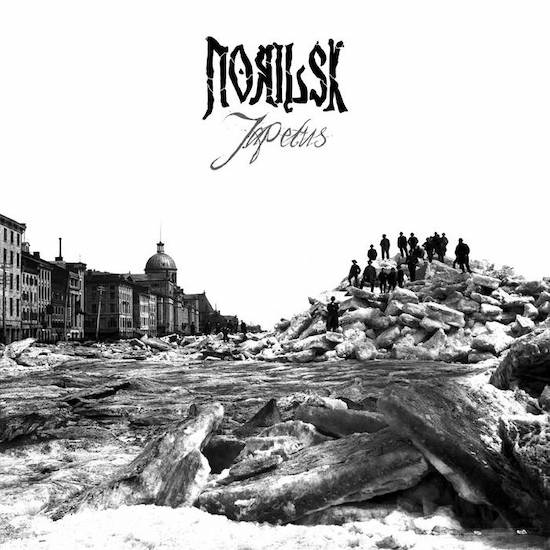
And what about the death-doom influences? Were the UK Three your primary priorities from the beginning?
One can’t ignore the UK Three, as they’ve influenced so many other bands. For Nick Richer, I think My Dying Bride’s early drumming patterns were an important influence. There’s also some of the Paradise Lost dual guitars and early Anathema influences here and there in our music. However, bands like Thergothon, Morgion, Winter, (early) Katatonia, Shadow of the Torturer, Saturnus, and Officium Triste, to name a few, may have had equal influences on us.
Nice choice, though Shadow of the Torturer is an unexpected reference for me here. Why do you think doom in general never was that popular or wide-spread in Canada?
I see it as two-fold until the early 2000s. On the one hand, there was a race for the most extreme genres (speed metal, death metal, technical metal, etc) since the ’80s. On the other hand, before the Internet and during the tape-trading years, the local scene was very important, and so were bands you could see live. I don’t think there were many European doom bands touring Canada in the ’80s and ’90s, but we regularly had all of the Florida death metal bands touring, for example.
In my hometown, Luc Lemay created Gorguts after being introduced to Death, and Gorguts quickly became one of the alpha bands in town, and had a direct influence on a number of other local bands. As for Montreal or Toronto, these cities are known for being hot beds for speed metal, crossover, and technical death metal. In the 2000s, the Internet helped what tape-trading and magazines/fanzines had started: exposing Canada more to the underground, and catching up with doom metal.
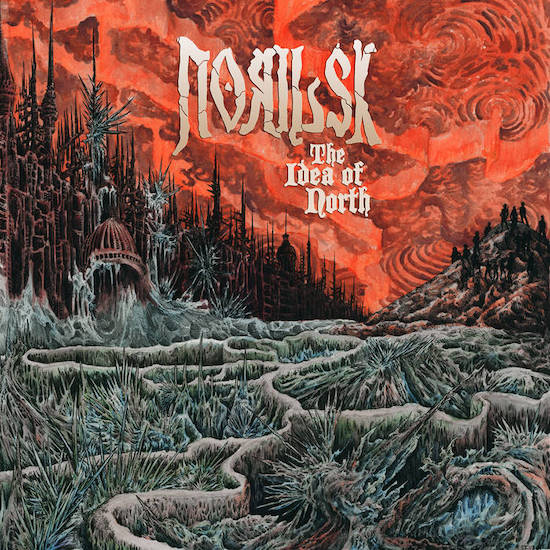
What was your plan when you started recording your first full-length, The Idea of North (2015)? What kind of sound did you search for back then?
The beginnings felt a little bit like a walk in the dark because we were still exploring different ideas, however it felt like a very natural and comfortable walk in the dark. It’s only after we finished writing the whole first album that we knew what the band would be about, how much death-doom would be in it, and how much other influences such as sludge and post-metal would also be incorporated. By the time we completed The Idea of North we knew that we wanted it to be slow, melodic, relatively basic in riffs, but slightly unorthodox in structure and eclectic in genre. In terms of sound, the whole sound exploration happened in the studio, where we worked with the sound engineer and tried different gear to give the album its own personality.
Which qualities of death-doom helped you to shape “the idea of North” concept? You know it’s a sort of cliché that if you’re going to praise North then black metal is your best friend.
Trve. In fact, we intentionally don’t sing about wolves and grim forests, but get our inspiration from more contemporary and more cultural topics. The Idea of North is the name of a 1967 radio documentary that famous pianist Glenn Gould did, where he interviewed people of various backgrounds, and discussed a number of topics associated with the North. Just like this documentary, our first album was more like a patchwork quilt, where the North can be defined from various perspectives, physically and metaphorically. In our death-doom universe, remote is the North and long are its nights – solitude is every man’s friend and doom is his lullaby.
And how did you collect these Nordic etudes? Did you base the music around your lyrics?
Some of the non-fiction references come from working with historians and with the cultural sector, but also from reading books, scientific journals, magazines, and blogs. Sometimes music is composed around lyrics or ideas, but most often I write my lyrics after the music has been composed.
Not many artists use French lyrics in their songs… Misanthrope, Mylen Farmer and… I don’t remember… Well, didn’t you think that this choice might affect the band’s popularity?
Popularity is quite debatable when it comes to underground genres. I may be bilingual, but French is my first language, and writing lyrics in French enables me to write better and more natural lyrics. So many bands write poor English lyrics because it’s their second or third language, and I think they should either get help or write in whatever language they’re best at. To me, it’s a matter of authenticity, not a statement. Having said this, I also like the diversity of accents especially in underground music.
Le passage des glaciers (2017) sounds like a proper development of The Idea of North‘s musical and lyrical concept. Did you see this material as an improvement on the debut album? How do you value this recording now?
You are correct in saying that Le passage des glaciers is a continuation of where we left of with the previous album. Musically, we tried to have a more diversified and more melodic album, something that expands our palette while offering excellent live material. Lyrically, it’s slightly more focused on the topic of loss, and the North symbolically becomes that distant valley of death. What’s left after the passage of glaciers says it all.
While I like The Idea of North for its heavy, rough, and imperfect character (many songs on the record were first takes), I think Le passage des glaciers brings a certain level of sophistication and ‘hooks’ to our music.
Did people react differently to Le passage des glaciers? Did this album help you to gain a wider audience?
When The Idea of North was released, it seemed to appeal to fans of doom-death, post-metal, and stoner metal to some degree. In contrast, Le passage des glaciers seemed to appeal to certain fans of blackened doom as well as doom-death and post-metal. There has been a slightly wider exposure, but maybe it has something to do also with the fact that Le passage des glaciers was a second album and built on the visibility of the first album, and the promotion and support we received.
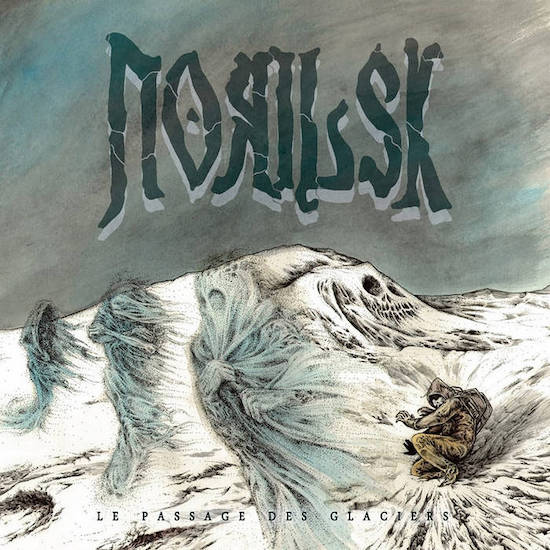
There’s the song “Namolennye” on Le passage des glaciers, and it has a quite specific background. What’s the story behind it?
“Namolennye” is a unique word to Russian language – it doesn’t really translate to English nor French. The concept of praying to an icon, and before an icon, has a specific significance in the context of religious rites, and mass – same with the iconostasis which separates the nave from the sanctuary, the divine from the earthly. Our song is not about Orthodox religion, but rather a dystopian analogy: it’s about a great separation, held by people in power; it’s about disappearing (or being forced to disappear) into the mass, and losing one’s sense of identity. It’s an acknowledgement that generations are born behind the wall, and empathy for the world they live in. The song ends with a quote from Pushkin about laying to rest by his beloved countryside.
Are you religious?
I am an art historian. Band members have their own culture and beliefs, however Norilsk has no religious affiliation whatsoever.
The band’s name and that song lead to this obvious question: what was the feedback from Russia? Did you get some positive vibes from here?
On the one hand there are all the comments about the name, and memes about Norilsk touring with KYPCK. I understand why people’s initial thoughts may be that Norilsk is a pastiche of Russia, but I leave these pastiches to others who like to sing about wolves. On the other hand, there are a number of doomsters from around the world getting interested in the city of Norilsk now, and proud metalheads from Norilsk (or who lived there before) reaching out to us, which is very humbling.
A Russian tour sounds like an absolutely fantastic idea, especially now, so what about your touring in Canada and maybe the US? How often? How difficult is it?
Touring in Canada is difficult because of the vast distances to cover, and with the rising price of gasoline, it makes it tougher. Touring in the US is equally difficult because of the visas and promoters – when you are a long way from home, all bands appreciate having some guarantees. Touring in Europe sounds like a good idea because of the shorter distances between cities and receptive audiences, however in most instances you still need to cover your flight tickets and find other bands/promoters to help with the logistics. While we liked our previous touring experience, and all shows and festivals that we played, we haven’t played live since the beginning of the pandemic.
Coming from a Nordic country, it’s common to catch a cold on tour, especially when you’re tired and sharing your space with people all the time. Have you ever headbanged onstage with a fever or a runny nose? It’s not my favourite thing but this happens when touring across the Great White North. With the pandemic maybe this will become more frequent, who knows?
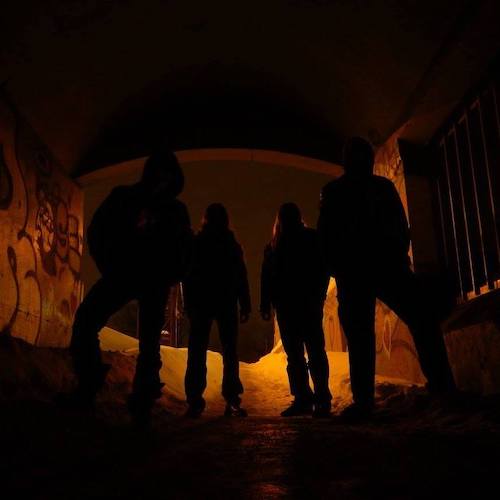
How did you get in the Black Mourning Light Festival line-up? It looks like a pretty true and pretty evil festival.
It’s true that when we played at the Black Mourning Light Festival, in Edmonton, there were pigs’ heads on spikes around the stage. We thought they were really cool and realistic props until we got onstage and saw the other side of the heads. We learned afterwards that one of the festival volunteers salvaged them from the butcher shop where he was working. Despite all of the decorum, the organization was extremely kind and accommodating. The main organizer is a fan of Norilsk and simply invited us.
Graphic elements play a big role in your art — the vinyl edition of The Idea of North is gorgeous…
We love the additional layer that graphic art adds to each album, and we take great care in commissioning art, and pairing EPs and full lengths. The artwork for The Idea of North was designed by Sam Ford, based on a 19th Century historical photograph of the old port of Montreal that we used for the Japetus EP.

Norilsk turned out to be more complex with Weepers of the Land (2018). How naturally were all these post-elements incorporated into your music?
We recorded Weepers of the Land during the same recording session as Le passage des glaciers. We had so much new material by then that we decided to split it into two records: one more focused (Passage), and the other one presenting what was slightly more exploratory (Weepers). I think the post-elements were there since the beginning, but were more fully developed during that recording session, and how we placed the songs on each album possibly contributed to showcasing these elements.
Honestly I didn’t see many reviews for Weepers of the Land, but it seems that people didn’t dig it as much as with the previous albums. How do you value this material now, and this decision to release it as a separate album?
I still think it would have been too much to release them as one double album, and that it needs to be seen as a companion mini-album to Le passage des glaciers. I recognize that Weepers of the Land has a degree of eclecticism that prevents it from being a good introduction to Norilsk. However, it is a complementary piece in the band’s discography because of the various guest appearances, contributors, and context leading to the creation of some of the songs.
Post-metal is a different phenomenon but I know that doom and post-metal are considered to be almost identical genres in the US. Do you care much about your connection with a certain scene?
I don’t really care about tags – I like all forms of traditional doom, death-doom, and funeral doom, post-metal, stoner, and sludge – but I see a lot of reaction from these scenes when the genres blend together. For example, we got to play post-metal shows on a few occasions (and enjoyed it), but with our long hair and guttural growls we have been slightly standing out, as if we’re too old school. Similarly, when playing with more traditional death-doom bands, we may not be death metal enough. And at the other end of the spectrum, the traditional doom scene seems to be ignoring our existence completely hahah.

You have a new EP Beyond the Mountains “released on the tipping point at the end of the world”. Humanity truly faces new old challenges right in front of it and fails to solve most of its current problems. Are you pessimistic regarding our future?
We live in the doomiest of modern times, and the last two years have seen record levels of caricatures and absurdity. Despite all of this, I like to think that people will find a way.
“Beyond the Horizon” and Officium Triste’s cover sound in an absolutely old school death-doom way. How did you manage to return to this sound? May we expect the same on your next album?
I take this as a compliment coming from you. The intent behind this EP was definitely to take OT’s 25th anniversary as an opportunity to strip down our music to its essence, and reconnect with its roots. It may not be a representative window into our next album, but rather a window into the album that got ‘lost’ in 2019.
You see, I write and record most songs directly onto my computer and store them away until it’s time to show them to the band prior to recording them. Unfortunately my computer crashed in 2019 and I lost decades of memories, photos, original files and personal documents, including a batch of new Norilsk songs. The only song that we got to retrieve and record from these archives was ‘Beyond the Horizon’. I learned my lesson and do backups now.
That’s just a natural disaster! So you had almost a full album done and now it’s lost?
Correct. There was approximately two-thirds of an album written, in various draft stages including lyrics, plus a long list of song embryos, riff banks, and ideas.
“Beyond the Horizon” is dedicated to natives of Northern America. What attracted you to their story?
The North is full of tragedies that inspire doom stories, and Canada has its own share. Our country has been on the path to Reconciliation with its Indigenous Peoples for a number of years, and that path requires acknowledgment of modern-day colonial practices, in order to forgive and heal. “Beyond the Horizon” is about the Inuit High Arctic Relocations in Canada, a well-documented and terrible story of forced relocation to the High Arctic, which had deep and permanent impact on the Inuit and northern communities.
How many of such documentary songs do you have in Norilsk’s albums?
There’s maybe half a dozen songs with a documentary element to them. Some are artistic references, some use historical references, others are inspired by true events. The only other song with an indigenous reference is “Weepers of the Land” and it was co-written with Joshua Cayer of Longhouse.
What are your plans for the next full-length album? How much new material do you already have?
A new full-length album has been written, but the rehearsal and arrangements have been slowed down by the pandemic. Our plans for the next few months is to rehearse the material as a full band, rather than as a duo, prior to recording it. We intend to take our time to do a demo, get some feedback, and work on the arrangements prior to hitting the studio.
Okay, Nicolas, let’s hope that we’ll have an opportunity to relax and listen new Norilsk with all attention. Thank you for the interview, and if we forgot to cover any question then just bring it on!
Thank you Aleks for the interview and for the ongoing support to the scene. We also have a number of music videos, and they are another way to discover Norilsk (https://norilskdoom.com/Videos.php).
